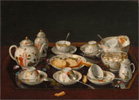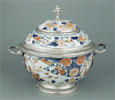
The materials in this curriculum are designed for elementary and secondary teachers to prompt classroom discussion and learn about Asian influences in Europe in the 18th century through visual arts, language arts, and social science lessons.
The lessons investigate chinoiserie, the cultural and artistic trend that produced objects and paintings reflecting Chinese subjects and motifs. In its broadest sense, chinoiserie was meant to evoke the spirit and decorative forms of faraway lands as diverse as China, Japan, India, and the Middle East.
|
 |
|
The Poetry of Chinoiserie
Grades/Level: Middle School (6–8), High School (9–12)
Subjects: Visual Arts, History—Social Science
Lesson Overview: Students will examine works of art that incorporate Asian export objects, and then respond to them using Japanese haiku poems.
|
 |
 |







